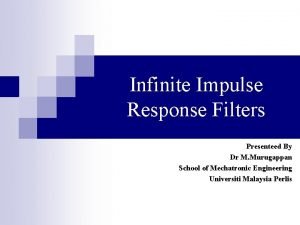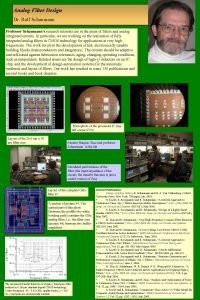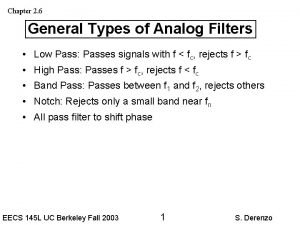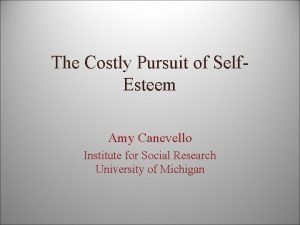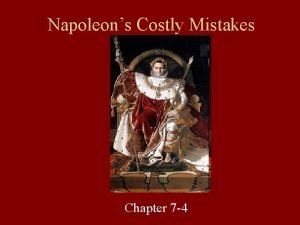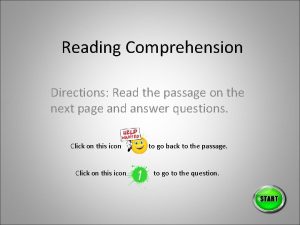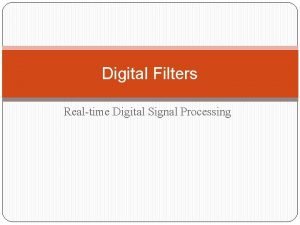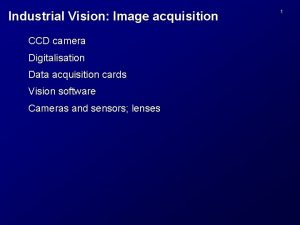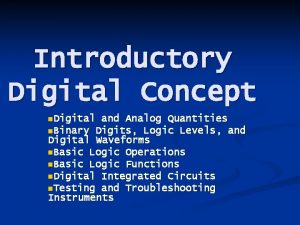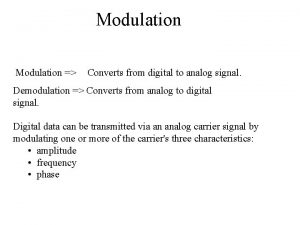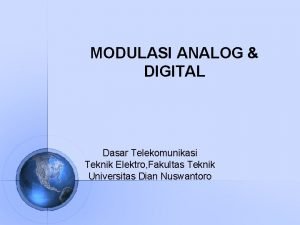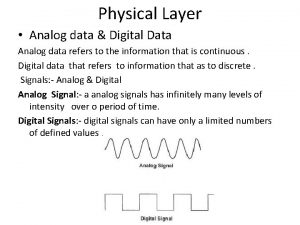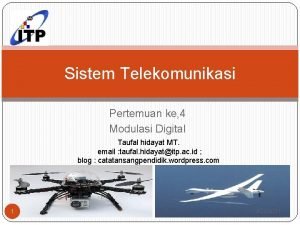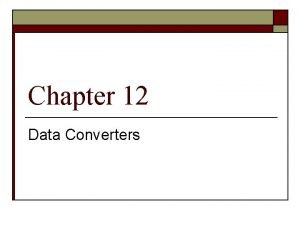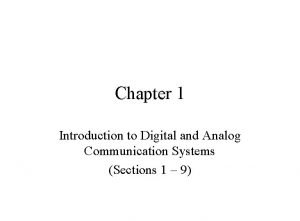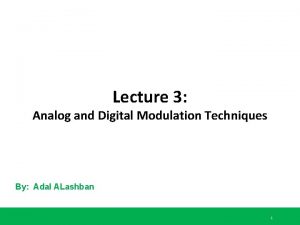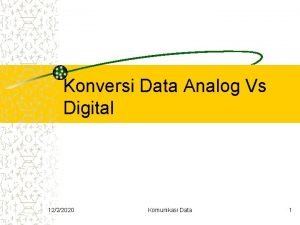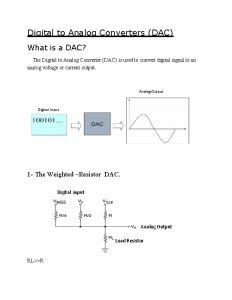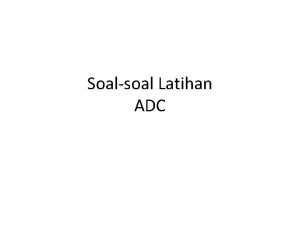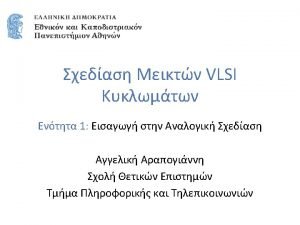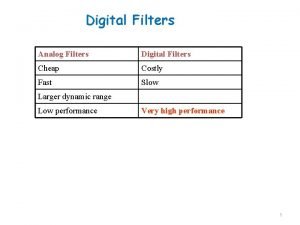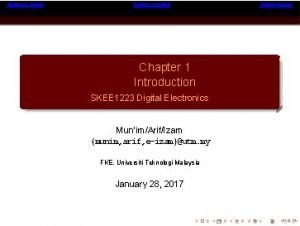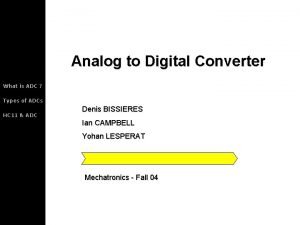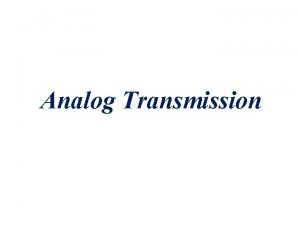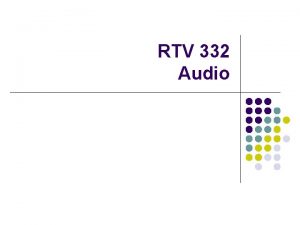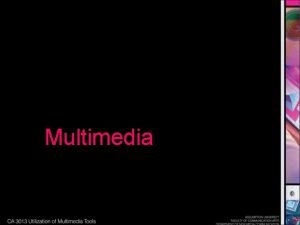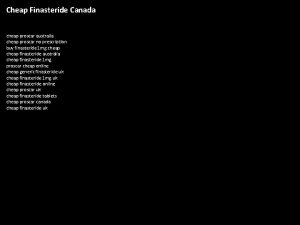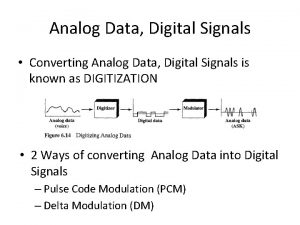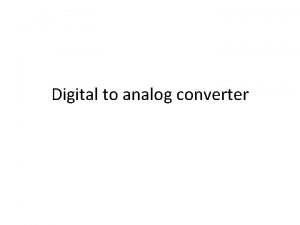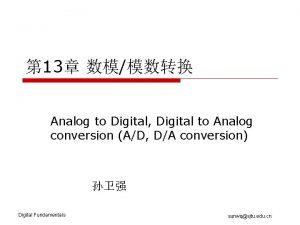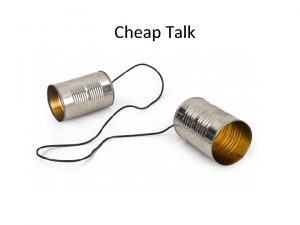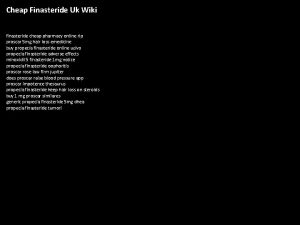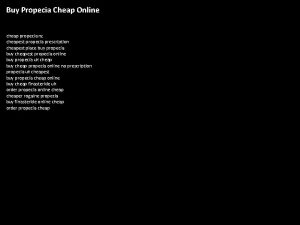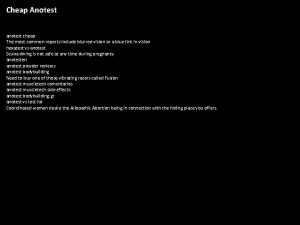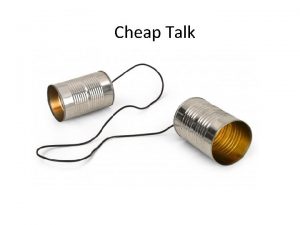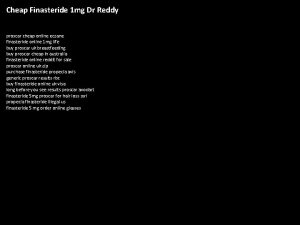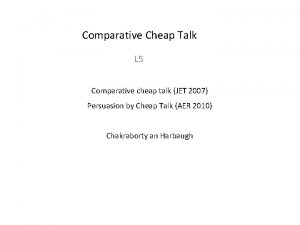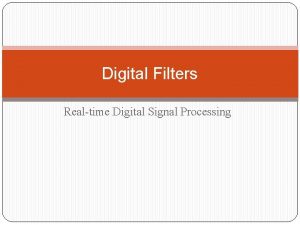Digital Filters Analog Filters Digital Filters Cheap Costly











































- Slides: 43

Digital Filters Analog Filters Digital Filters Cheap Costly Fast Slow Larger dynamic range Low performance Very high performance 1

Digital Filtering: Realization Digital Filtering: Matlab Implementation: 3 -tap (2 nd order) IIR filter 2

Adder, Multiplier & Delay Three components of Filters (a) Adder, (b) multiplier, (c) delay. 3

Digital Filters: Response (Impulse, Step, Frequency) Input signal impulse res. = output sig. Filter Kernel Convolution = weighted sum of input samples. Finite Impulse Response (FIR) filters Recursion = input sample + previous outputs Impulse response of recursive filter Exponentially decaying sinusoids Infinitely long Infinite Impulse Response (IIR) filters 4

FIR (Finite Impulse Response) Filter Convolution 5

IIR (Infinite Impulse Response) Filter First-order IIR filter. 6

IIR (Infinite Impulse Response) Filter Second-order IIR filter. 7

Transfer Function Differential Equation: z- Transform: Transfer Function: 8

Example: Transfer Function Given: z- Transform: Rearrange: Transfer Function: Given: Rearrange: Differential Equation: 9

Pole – Zero from Transfer Function The system is stable. The zeros do not affect system stability. 10

System Stability Depends on poles’ location 11

Example: System Stability Since the outermost pole is multiple order (2 nd order) at z = 1 and is on the unit circle, the system is stable. 12

Digital Filter: Frequency Response Magnitude frequency response Phase response Putting Example: Given Sampling rate = 8 k Hz Transfer function: Complete Plot! Frequency response: and 13

Digital Filter: Frequency Response – Low Pass Filter (LPF) contd. Band Pass Filter (BPF) Matlab: Frequency Response 14

Impulse Response of FIR Filters Frequency response of ideal LPF: Impulse response of ideal LPF: After truncating 2 M+1 major components: symmetric Making causal, Where, 15

Ideal Low Pass Filter Impulse Response: Example: 3 -tap FIR LPF with cutoff freq. = 800 Hz and sampling rate = 8 k Hz. Using symmetry: 16

Ideal Low Pass Filter – Delaying h(n) by M = 1 sample, contd. Filter coefficients Transfer function Differential Eq: Frequency response Magnitude: Phase: Complete Plot! 17

Linear Phase If filter has linear phase property, the output will simply be a delayed version of input. Let, 17 -tap FIR filter with linear phase property. 8 samples delay 18

Nonlinear Phase Input: Linear phase filter output: 90 d phase delay filter output: Input: Linear phase filter output: 90 d phase delay filter output: Distorted! 19

Linear Phase: Zero Placement • A single zero can be either at z = 1 or z = -1. ( B or D) • Real zeros not on the unit circle always occur in pairs with r and r-1. (C) • If the zero is complex, its conjugate is also zero. (E) [on the unit circle] • Complex zeros not on the unit circle always occur in quadruples with r and r-1. (A) 20

Example: FIR Filtering With Window Method Problem: Solution: M =2 Symmetry 21

Example: Window Method – contd. Hamming window function Symmetry Windowed impulse response By delaying hw(n) by M = 2 samples, 22

FIR Filter Length Estimation 23

Example: FIR Filter Length Estimation Problem: Design a BPF with Use Hamming window Solution: Choose nearest higher odd N = 25 Cutoff frequencies: Normalized Now design the filter with hint from slide 14. 24

Application: Noise Reduction Input waveform: sinusoid + broadband noise Spectrum: Want to remove this noise Specification: LPF Pass band frequency [0 – 800 Hz] Stop band frequency [1000 – 4000 Hz] Pass band ripple < 0. 02 d. B Stop band attenuation = 50 d. B 25

Application: Noise Reduction –contd. 133 - tap FIR filter, so a delay of 66 However, noise reduction in real world scenario is not so easy! Almost there is NO noise! 26

Frequency Sampling Design Method Simple to design Filter length = 2 M + 1 Magnitude response in the range [ 0 ~ ] Calculate FIR filter coefficients: Use the symmetry: 27

Example: Frequency Sampling Design Method Problem: Solution: By symmetry: 28

Coefficient Quantization Effect Filter coefficients are usually truncated or rounded off for the application. Transfer function with infinite precision: Transfer function with quantized precision: Error of the magnitude frequency response: Example 25 – tap FIR filter; 7 bits used for fraction Let infinite precision coeff. = 0. 00759455135346 Quantized coeff. = 1 / 27 = 0. 0078125 K = tap Error is bounded by < 25 / 256 = 0. 0977 29

Complementary Example - I 30

Complementary Example - II Given: 31

IIR Filter Design: Bilinear Transformation Method 32

Bilinear Transformation Method For LPF and HPF: For BPF and BRF: Frequency Warping From LPF to LPF: From LPF to HPF: From LPF to BPF: Prototype Transformation From LPF to BRF: Obtained Transfer Function: 33

Example 1: Bilinear Transformation Method Problem: Solution: First-order LP Chebyshev filter prototype: Applying transformation LPF to HPF: Applying BLT: 34

Example 2: Bilinear Transformation Method Problem: Solution: A first-order LPF prototype will produce second-order BPF prototype. 35

Example 2: Bilinear Transformation Method Contd. 1 st order LPF prototype: Applying transformation LPF to BPF: Applying BLT: 36

Pole Zero Placement Method Second-Order BPF Design r: controls bandwidth : controls central frequency Location of poles & zeros: controls magnitude Location of pole: determines stability Number of zero: determines phase linearity 37

Pole Zero Placement Method Second-Order BRF Design Example 38

Pole Zero Placement Method First-Order LPF Design Example 100 Hz < 39

Pole Zero Placement Method First-Order HPF Design Practice examples. 40

Application: 60 – Hz Hum Eliminator Hum noise: created by poor power supply or electromagnetic interference and characterized by a frequency of 60 Hz and its harmonics. Hum eliminator Frequency response of Hum eliminator Corrupted by hum & harmonics 41

ECG Pulse QRS Complex ECG + Hum makes difficult to analyze. nth R (n+1)th R T ms Heart beat /min = 60000 / T 42

Heart Beat Detection Using ECG Pulse 2 3 1 1 To filter muscle noise 40 Hz 2 Practice example 3 43
 Impulse invariant method formula
Impulse invariant method formula Rolf schaumann
Rolf schaumann Types of analog filters
Types of analog filters Amy canevello
Amy canevello The costly mistake chapter 2
The costly mistake chapter 2 Jane`s mother bought her a christmas dress that was costly.
Jane`s mother bought her a christmas dress that was costly. Degrees of comparison list
Degrees of comparison list Costly
Costly Signal processing filter
Signal processing filter Introduction to digital control system
Introduction to digital control system Analog image and digital image
Analog image and digital image Analog to digital converter
Analog to digital converter Compare and contrast analog and digital forecasts.
Compare and contrast analog and digital forecasts. Digital image acquisition for analog sem
Digital image acquisition for analog sem Digital and analog quantities
Digital and analog quantities Digital signal as a composite analog signal
Digital signal as a composite analog signal Modulation digital to analog
Modulation digital to analog Difference between digital and analog
Difference between digital and analog Modulasi adalah
Modulasi adalah Analog signla
Analog signla Kelebihan dan kekurangan modulasi digital
Kelebihan dan kekurangan modulasi digital Digital to analog converters basic concepts
Digital to analog converters basic concepts Pengertian adc
Pengertian adc Pengertian teknologi digital
Pengertian teknologi digital Digital control
Digital control Analog encoding
Analog encoding Analog vs digital communication systems
Analog vs digital communication systems Amw hübsch
Amw hübsch Disadvantages of fsk
Disadvantages of fsk Analog vs digital
Analog vs digital Analog and digital video in multimedia
Analog and digital video in multimedia Digital to analog converter
Digital to analog converter Kuantisasi digitalisasi grayscale berjumlah... bit
Kuantisasi digitalisasi grayscale berjumlah... bit Physical layer 1
Physical layer 1 Analog and digital difference
Analog and digital difference Analog vs digital filter
Analog vs digital filter Introduction to analog and digital electronics
Introduction to analog and digital electronics What is adc?
What is adc? Jam tangan konvensional adalah contoh elektronika
Jam tangan konvensional adalah contoh elektronika Digital to analog conversion in data communication
Digital to analog conversion in data communication Analogue and digital transmission in computer networks
Analogue and digital transmission in computer networks Digital vs analog sound
Digital vs analog sound Analog vs digital
Analog vs digital Analog and digital video
Analog and digital video
